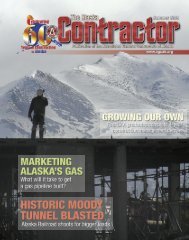The Alaska Contractor: Special 60th Anniversary Issue
The Alaska Contractor: Special 60th Anniversary Issue
The Alaska Contractor: Special 60th Anniversary Issue
You also want an ePaper? Increase the reach of your titles
YUMPU automatically turns print PDFs into web optimized ePapers that Google loves.
“One of the big projects that I<br />
remember was MB Contracting had<br />
the contract to service concrete on<br />
Elmendorf. <strong>The</strong>y were doing runways<br />
out there.<br />
“In those days the cement was<br />
bid by the companies and then they<br />
would furnish the cement to the ready<br />
mix companies. <strong>The</strong>re weren’t very<br />
many ready mix companies around,<br />
but Kaiser had a contract to furnish<br />
bulk cement and then we would furnish<br />
it to MB or whoever.”<br />
Thinking back about the ready mix<br />
companies in Anchorage, Dougherty<br />
said, “Hinchey <strong>Alaska</strong> Aggregate was<br />
the largest one and then Anchorage<br />
Sand and Gravel was owned by the<br />
Waldron family—they were number<br />
two. That was about it.<br />
“I think APEX started in about ’57<br />
or ’58, but Hinchey was the big operator<br />
in the early days.”<br />
Getting product to <strong>Alaska</strong><br />
“For a long time we used barges,<br />
some LST barges. We would unload<br />
them with a pump. Now it all comes<br />
from foreign places on 25,000-ton<br />
ships. It’s still pumped off.”<br />
(Ed. Note: LST is the Navy’s acronym<br />
for Landing Ship Tank. Hundreds of these<br />
shallow-draft vessels were built for World<br />
War II and were sold cheaply as surplus<br />
in the late 1940s and early 1950s.)<br />
Kaiser never lost a barge hauling cement<br />
to <strong>Alaska</strong>, though they were often<br />
delayed by weather. But, “we lost one<br />
on a return trip,” Dougherty said. “<strong>The</strong>y<br />
ran into Rabbit Island down south of<br />
Seward. I think maybe they were asleep<br />
but nobody could prove it.”<br />
<strong>The</strong> cement hauled by the LSTs<br />
was essentially a dry powder which<br />
was pumped out of the ship when it<br />
arrived in Anchorage. According to<br />
Dougherty, “We [Kaiser] had a couple<br />
of pumps. It looked like a tractor only<br />
the front … instead of wheels you had<br />
two disks turning towards each other<br />
and they would feed the cement in<br />
this screw and air would come from<br />
the shore and pull it [cement] back to<br />
the silos.”<br />
<strong>The</strong> pipeline<br />
When asked about his favorite job<br />
over the years, Dougherty thinks in<br />
terms of the amount of concrete sold.<br />
“I suppose it would have to be the<br />
<strong>60th</strong> <strong>Anniversary</strong> <strong>Issue</strong> 1948–2008 <strong>The</strong> <strong>Alaska</strong> conTrAcTor 21

















